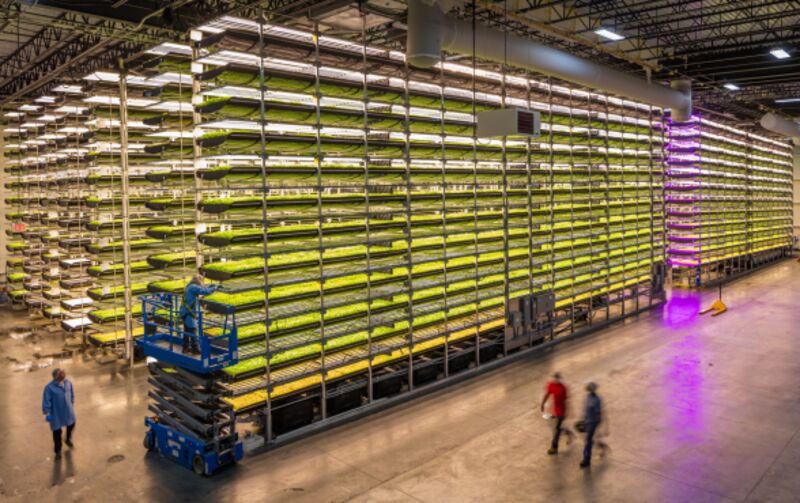TL;DR:
- Vertical farming startups, once fueled by venture capital, are facing funding challenges, elusive profits, and bankruptcy.
- AeroFarms Inc. recently filed for bankruptcy after investing heavily in a facility in Virginia.
- Kalera sought court protection, and AppHarvest Inc. received a default notice from an investor.
- Investors initially treated vertical farms as software firms but now prioritize profitability.
- Indoor farming remains important for the future of agriculture, but nationwide market share may take years to achieve.
- Funding for vertical farming has significantly decreased, leading to a shift in investor sentiment.
- Investors now focus on businesses that demonstrate profitability.
- AeroFarms is redirecting resources toward developing a profitable microgreens business.
Main AI News:
The revolutionary concept of vertical farming, fueled by venture capital investments, once seemed like a lucrative dream. With the promise of leveraging robots and artificial intelligence to address water conservation, food security, and environmental concerns, the potential was immense. However, as billions of dollars flooded into these startups, driving valuations to unprecedented heights, the industry now confronts a stark reality: dwindling funding, elusive profits, and mounting debt.
The recent bankruptcy filing of AeroFarms Inc. exemplifies the challenges plaguing the sector. Court documents reveal that the company exhausted its resources by constructing a massive facility in Virginia. Prior to this, lettuce grower Kalera sought court protection in April, and AppHarvest Inc., a publicly traded operator of high-tech greenhouses, received a notice of default from one of its investors in May, as stated in regulatory filings. Although AppHarvest contests the default notice, it issued a cautionary statement, warning of potential bankruptcy or insolvency if an agreement with creditors cannot be reached.
Vonnie Estes, Vice President of Innovation for the International Fresh Produce Association, reflects on the frenzy that gripped venture capitalists, comparing these agricultural enterprises to software firms while anticipating equivalent returns. However, as Estes emphasizes, the fundamental essence of these ventures lies in farming, a fact that was perhaps overlooked by many investors. Despite this setback, industry experts maintain that indoor farming remains a vital component of agriculture’s future, particularly as climate change exacerbates wildfires and floods. Nevertheless, achieving a substantial market share nationwide may still be years away for vertical farms.
Over the past decade, numerous startups sprouted up, with a select few enjoying a seemingly unending series of funding rounds. Companies like AppHarvest, headquartered in Kentucky, witnessed their valuations skyrocketing into the billions. AeroFarms, an early pioneer of vertical farming based in Newark, New Jersey, had ambitious plans to go public in 2021 via a blank-check merger, with an estimated equity value of $1.2 billion, illustrating its exceptional growth potential.
However, as interest rates began to rise, investors began scrutinizing profitability more intensely than in previous years. According to Adam Bergman, the global head of AgTech investment banking at Citigroup Inc., over $1 billion was raised for vertical farming last year. This year, that figure has plummeted to under $100 million. The shift from readily available capital to limited capital flows has prompted a change in investor sentiment.
AeroFarms’ President and CFO, Guy Blanchard, acknowledges this shift, noting that investors now prioritize businesses that demonstrate profitability. He explains that while investors previously viewed vertical farms as an infinite frontier of innovation, their focus has shifted to ventures that generate solid returns. Speaking from AeroFarms’ Newark facility via video conference, Blanchard reveals that the company is redirecting its resources toward developing a profitable microgreens business, set to achieve profitability by year-end.
The evolution of investor attitudes underscores the growing emphasis on tangible financial success. While the concept of vertical farming retains its significance in the future of agriculture, the industry must adapt to meet the expectations of investors seeking viable and lucrative enterprises. As funding diminishes and profitability becomes paramount, vertical farms must prove their ability to thrive within a competitive business landscape, ensuring long-term sustainability and success.

Source: AeroFarms
Conclusion:
The struggles faced by AI-driven lettuce farms in the venture capital market indicate a shift in investor priorities. While the concept of vertical farming remains significant for the future of agriculture, investors now demand profitable businesses. This changing landscape emphasizes the need for vertical farms to adapt and prove their ability to generate tangible financial success. The industry must navigate funding challenges, prioritize profitability, and demonstrate long-term sustainability to thrive in a competitive market.

